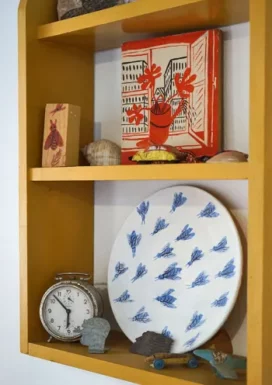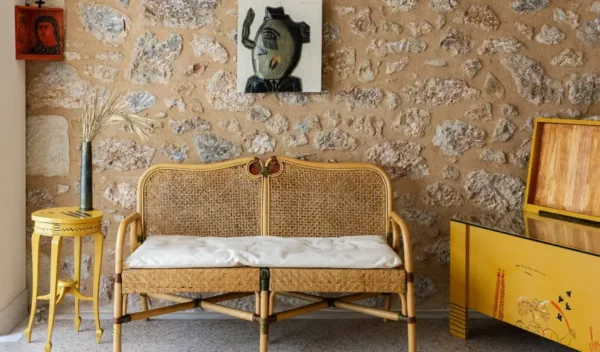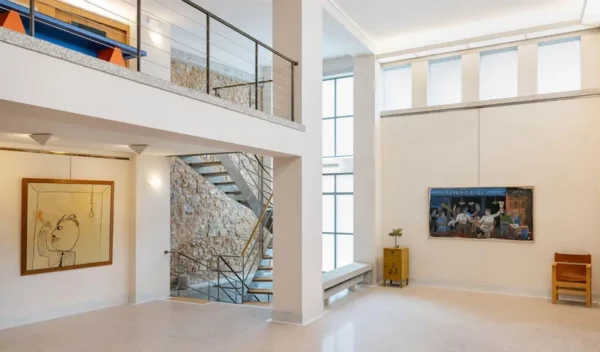The Alekos Fassianos Museum was designed and remodelled by architect Kyriakos Krokos, in collaboration with Alekos Fassianos, and it was completed in 1995. The location of the museum is where the artist’s family home used to be back in the 1930s and until the 1970s. It was a typical small neo-classical house with an inner courtyard and a tile roof. The family settled in this house when Alekos’ grandfather, Andreas, was appointed as priest at the church of Agios Pavlos.
The artist grew up in this vibrant Athenian neighbourhood, during the heyday of Athenian theatres & cinemas. He got acquainted with the local street trades and itinerant workers and vendors such as the milkman and the cobbler. In the late 1970s, the small house was torn down, at his mother’s request, to build a four-storey block of flats, which would provide her children with apartments to live in. Fassianos, who lived in Paris at the time, was devastated as he saw his family home disappear together with his childhood memories. In the late 1980s, Fassianos expressed his desire to Krokos to create a museum which would house his art collection. He wanted to reshape and renovate the building to include a private exhibition space and apartments. For Fassianos, this location was ideal as it was filled with childhood memories and his earliest inspirations, and because of its proximity to the city centre and the National Archaeological Museum.
The challenges, however, of such a project were not to be underestimated, as Krokos would need to work on an existing structure which inevitably presented a number of limitations. Fassianos and Krokos’ shared aesthetic and philosophical principles are evident in this project. The architectural style they wished to follow was simple and plain – as Krokos stated, “Things mustn’t spoil or age badly; they have to look and be clean-cut”.
The space was carefully remodelled using various materials including concrete, stone, mosaic tiles, brick, and plaster, and a palette of earthy shades of grey, red, and ochre. Krokos wanted the structure of the building to be highlighted and the materials to be visible, while Fassianos felt strongly about creating a space in dialogue with his works. The collaborators’ artistic and design sensibilities are apparent in the space’s structure, with various stone masonry finishes and the marble edging framing the terrazzo floor, as well as in details including the elaborate spiral staircase, mosaic works on the floors, fresco paintings on the walls, bronze door handles, and the metal dragon hanging from the basement ceiling, which was designed to hide the cabling. The Alekos Fassianos Museum holds a distinguished place on the contemporary artistic and architectural map of Athens for the masterly corrective intervention to an existing building and the particular and precise crafting of surfaces. It is also one of the few museums in the world in which the collaboration of the artist and the architect underpins the dialogue between the works of art and the space that houses them.



ALEKOS FASSIANOS BIOGRAPHY
Alekos Fassianos (25 October 1935 – 16 January 2022) was born in Athens. His father was a musician and his mother taught ancient Greek. He took violin lessons at the Athens Conservatoire and studied painting under Yannis Moralis at the School of Fine Arts in Athens from 1956 to 1960. In 1960, he received a scholarship from the French government and went to Paris to study lithography at the École des Beaux-Arts. After completing his studies in Paris in 1963, Fassianos returned to Athens.
Together with architect Antonis Kepetzis and artists Vasilis Sperantzas and Nikos Stefanou, they moved to an old house in Kallithea, which was granted to them by the National Gallery of Athens. The so-called Kallithea studio was their atelier, a place where artists and poets met. This is where Fassianos painted his first ‘smoking cyclist’. At the iconic Athenian Brazilian Café – a haunt for intellectuals, he befriended poets such as Odysseas Elytis, Miltos Sachtouris and Andreas Embirikos, who encouraged him to create a series of ‘cyclists with windblown hair’. In 1967, when the military junta seized the power in Greece, Fassianos moved permanently to Paris. Two years later, he was discovered by legendary art dealer Paul Facchetti. They began a fruitful collaboration, with Facchetti exhibiting Fassianos’ works alongside those of fellow Parisian artists Jean Paul Riopelle and Georges Mathieu. For Fassianos, the solo shows organised by Facchetti were crucial for furthering his career as they marked the first comprehensive showcasing of his artistic idiom.
In the 1970s, he was represented by Alexander Iolas Gallery, and he saw his works of art exhibited alongside those by Max Ernst, René Magritte, Giorgio de Chirico and Martial Raysse. Fassianos’ works travelled from Malmö to Tokyo, Zurich, Berlin, Milan, and New York and in 1983, Blaise Gautier organised a monograph presentation of the artist’s work at Centre Pompidou in Paris, as part of the periodical ‘Revue parlée’. In 1985, the Château de Chenonceau presented the artist’s first retrospective, followed by a series of gallery & museum exhibitions around the world.
Apart from being a painter, Fassianos was also a writer, poet, ceramic artist, designer, stage designer, and architect. He created the costumes and stage sets for numerous plays including Franz Kafka’s America and Euripides’ Helen at the National Theatre of Athens, and in 1980 he oversaw the scenography for the play ‘No Exit’ by Jean-Paul Sartre. Throughout his career, Fassianos illustrated numerous editions for writers and poets such as Miltos Sachtouris, Odysseas Elytis, Constantin Cavafy, Yannis Ritsos, Kostas Tachtsis, Louis Aragon, Guillaume Apollinaire, Jacques Lacarrière, Paul Valéry, Fernando Arrabal and Jean-Marie Drot, among others. He also illustrated limited edition publications with Bruno Roy, editor of Fata Morgana, and the publisher André Biren. Fassianos created design objects such as furniture, lighting items, door handles and homeware for his residences in Athens and Kea.
During his lifetime, Fassianos was named an Honorary Member of the Russian Academy of Arts, he was commended as an Officier de la Légion d’Honneur by the French Minister of Culture Frédéric Mitterand, and, in 2021 he received the highest award of Commandeur de l’Ordre des Arts et des Lettres by Roselyne Bachelot-Narquin, the French Minister of Culture.
Source
Author: Visit Greece
Website: visitgree.gr
